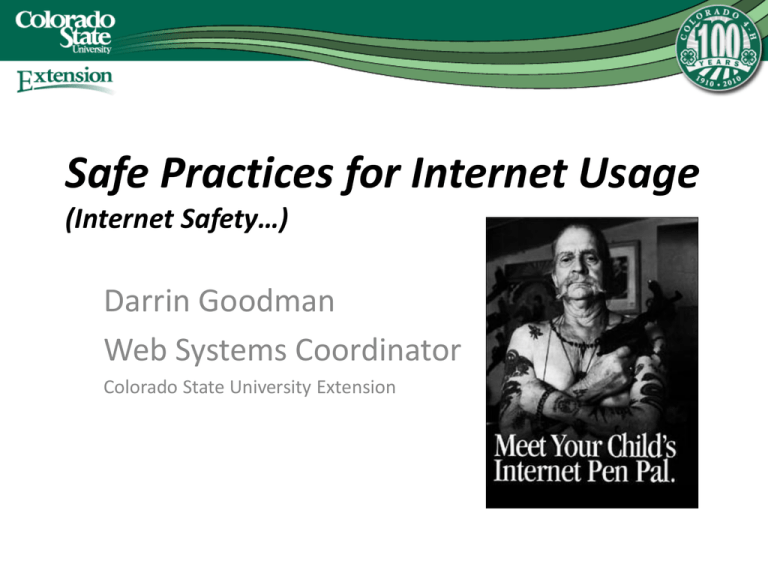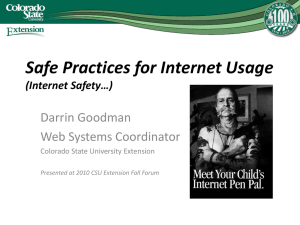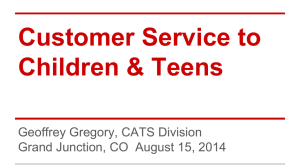
Safe Practices for Internet Usage
(Internet Safety…)
Darrin Goodman
Web Systems Coordinator
Colorado State University Extension
What is Internet Safety?
Internet safety or online safety is the security of
people and their information when using the
Internet. Internet safety means protecting your
personal information while online. Details such as
your address, full name, telephone number, birth
date and/or social security number can potentially
be used by on-line criminals.
Adapted from:
- Wikipedia: http://en.wikipedia.org/wiki/Internet_safety
- eHow: http://www.ehow.com/about_6577504_definition-internet-safety.html
Personal Protection From…
•
•
•
•
•
Internet Predators
Coffee-Shop-Data-Collectors
“Script-Kiddies”
(what you might think of as “hackers”)
Viruses / Trojans / Ad-Ware
Those who take advantage of children & teens
–
–
–
–
•
Use “Social Engineering” to manipulate victim
Sexual Intentions
Murderous Intentions
Other Malicious Intent
Phishing Attempts
(Masquerading as a trustworthy entity while attempting to acquire
sensitive information)
•
Scam Artists
– Email scams are meant to take your money
– Scams on Craigslist that are using you to commit fraudulent
activities
Coffee-Shop-Data-Collectors
• Most public wireless connections are NOT
secure
• It’s easy to capture your data
• Don’t log into websites that reveal your
sensitive credentials (email, bank account, etc.)
• Use onboard firewall software
• Lock your screen before leaving your seat
• Don’t store sensitive information on your
computer
• Use an encrypted VPN (Virtual Private Network)
Coffee Shop Scenario
Typical unsecured wireless connection.
This is what you think that you are logging into…
Man In The Middle Attack
The Man-In-The-Middle grabs and/or modifies data that is sent/received.
http://www.interlinknetworks.com/whitepapers/Link_Layer_Security.htm
VPN – Virtual Private Network
Protect your traffic by encrypting it.
•
•
•
http://myvpnreviews.com/
http://en.wikipedia.org/wiki/Virtual_private_network
http://www.interlinknetworks.com/whitepapers/Link_Layer_Security.htm
Youth Online Safety
• It is clear, then, that the definition of “youth online
safety” has broadened and become more complex in
the past 10 years, as have the role of the online user
and the inter-connected devices today’s user takes
advantage of when consuming, socializing, producing,
and connecting. In addition to cyberbullying,
inappropriate content, and predation, other risks have
emerged, including “sexting” and the risks related to
geolocation technology in online applications and on
mobile phones.
• Source: OSTWG Article, "Youth Safety on a Living Internet“
Online Safety and Technology Working Group (OSTWG)
Desired Outcomes
• Physical Safety – freedom from physical harm
• Psychological Safety – freedom from cruelty,
harassment, and exposure to potentially
disturbing material
• Reputational and Legal Safety – freedom from
unwanted social, academic, professional, and
legal consequences that could affect users for a
lifetime
• Identity, Property, and Community Safety –
freedom from theft of identity & property
Statistics
• 75% of children and teens report sharing personal
information about them and their families to complete
strangers in chat rooms1
• 93% of American teens (ages 12-to-17) use the
Internet2
• 73% of American teens use social network sites2
• 75% of American teens own cell phones2
• 4% of American teens have sent sexually suggestive
images or videos of themselves via cell phone, and 15%
have received such images from someone they know2
• 43% of teens have been victims of cyberbullying3
Sources are referenced in Resources slide near the end of this presentation
Avenues for Online Communication
• Avenues for online child
communication: blogs, chat
rooms, irc, IM, Facebook,
Facebook chat, MySpace,
Orkut, email, Skype, Twitter,
Identica, Craigslist, forums,
text messages, etc….
Protection Methods for Youth (& you!)
• Educate your child about the dangers that
exist on the Internet
• Studies show that:
– Fear-based scare-tactics are not effective
– Use the "norms" approach - suggest that [insert
behavior here] is not a “norm” among youth's
peers and that people who engage in such activity
are abnormal and may need help
Protection Methods for Youth (& you!)
• Educate you child about safe Internet practices
• Use strong passwords (including numbers, special characters,
and combination of upper/lower case)
• Never give password to anyone
• Don't communicate online with people you don't know
• Enable & elevate privacy settings in Facebook
• Disable Facebook Chat
• Do not allow Skype calls from anyone who is not on your
contact list
• Teach kids about responsible communication
Protection Methods for Youth (& you!)
• Do not share specific information about yourself, such as family info,
where you live, photos of yourself or your home, etc.
• Use an alias for Web communications, not your real name / also use
avatar that is different from your actual photo
• Don't say anything online to someone that you would not be willing to say
directly to their face in person
• Don't open email attachments unless you know for certain what it is
• Be aware that actions have consequences - ex: nude photos, bad
language, inappropriate conduct, etc. - could have legal impacts,
embarrassment, or affect future job opportunities
• Inform you (the parent or another authority figure) if the child has
experienced anything online that makes him/her feel creepy or
uncomfortable
Protection Methods for Youth (& you!)
• Use Internet Content Filters
– Software that filters out unwanted websites, such as
pornography
– IP Addresses can be filtered using your router or your Web
browser
• Place computer in living room or other "common" area
within your home
• Regulate length of time child spends on Internet as well as
determine a window of time for usage
• Request list of email and social networking sites being used
and username/password for each account
• Perform random checks on your teenager's cell phone to
view text messages sent/received
Passwords
• Strong Passwords:
– Phrases, mixed case, special characters, and long:
- 5db10mw! (Slow Down Buddy I’m On My Way!)
- w@yD0wny0nd3r#% (Way Down Yonder #%)
Passwords
• Password Card:
– http://www.passwordcard.org/en
Content Filtering
•
Commercial Software for Content Filtering:
–
–
–
–
–
–
–
–
–
•
Free Software for Content Filtering
–
–
–
–
•
OpenDNS - FamilyShield: http://www.opendns.com/familyshield
Parental Filter: http://www.softpedia.com/get/Security/Lockdown/Parental-Filter.shtml
K9 Web Protection: http://www1.k9webprotection.com
ProCon Latte: http://procon.mozdev.org (read interesting related article)
Content Filtering for Firefox
–
–
–
•
Cyber Patrol: http://www.cyberpatrol.com
CyberSitter: http://www.cybersitter.com
InternetSafety: http://www.internetsafety.com/safe-eyes-parental-control-software.php
ContentWatch: http://www.contentwatch.com
NetNanny: http://www.netnanny.com (powered by ContentWatch - also works on mobile devices)
Panda Internet Security: http://www.pandasecurity.com/security-promotion/usa/panda-internet-security
PC TattleTale Parental Control: http://www.pctattletale.com
Aobo Porn Filter - Website Blocker: http://aobo.cc/aobo-porn-filter.html
Sentry Parental Controls: http://www.sentryparentalcontrols.com
KidZui - a safe browser and online playground for kids 3-12
FoxFilter Add-on for Firefox
Interesting article on using manual proxy configurations
Filtering Content with IE's Content Advisor
Cyberbullying
What is it?
• Cyber Bullying occurs when people send or post
mean or threatening text or pictures on the
Internet. Examples:
• A kid could post stories about another kid online.
They could show the website to all of their friends.
When the victim goes back to school, he/she gets
teased about something they don’t know about.
• If a friend had your password, and you got into a
fight, they could send mean emails to everyone in
your address book. When your friends or family
open the email, they would think that it came from
you! They could feel very hurt and upset.
Source: http://library.thinkquest.org/06aug/01158/home.html
Cyberbullying
Possible warning signs of children being bullied or bullying other children
• Complaining that other children or a group of
children do not like them.
• Preoccupation with friendship concerns.
• Poor self-esteem. Feeling they are not as good as
others.
• Not wanting to go to school or other activities.
• Spending a great deal of time on the computer.
• Being secretive about online activities.
•
Source: Internet Safety PowerPoint - A Parent's Guide to the Internet:
http://criminaljustice.state.ny.us/missing/i_safety/mediafiles/isafety_parents6.ppt
Cyberbullying
Dealing with Cyberbullying
• Preserve evidence – this is crucial for identifying the bully
and making a case.
• Attempt to enlist assistance from the service provider.
• If able to identify the bully, contact him or her and/or
parents.
• Use available blocking technology (i.e., block the user on
IM, email and chat.)
• In serious cases, seek assistance from the police (i.e.,
threats of physical harm, unrelenting or unable to stop.)
•
Source: Internet Safety PowerPoint - A Parent's Guide to the Internet:
http://criminaljustice.state.ny.us/missing/i_safety/mediafiles/isafety_parents6.ppt
Cyberbullying
Dealing with Cyberbullying
Some links worth looking at:
• http://wiki.ucalgary.ca/page/Cyberbullying
• http://www.stopcyberbullying.org
• http://www.wiredsafety.org/
• http://www.wiredsafety.org/fbprivacy/index.htm
“Sexting”
• A recent study by the Pew Internet &
American Life Project “found that 4% of cellowning teens ages 12-17 say they have sent
sexually suggestive nude or nearly nude
images or videos of themselves to someone
else via text messaging.” Fifteen percent of
young respondents “say they have received
such images of someone they know via text
message.”
•
Source: OSTWG Article, "Youth Safety on a Living Internet"
“Sexting” - Consequences
• Photos sent to boy/girlfriend could potentially be
distributed over school, especially after a breakup
• One could suffer legal consequences after distributing nude
photos of an underage minor
– criminal charges
– listed as registered sex offender
• Criminal charges could result in...
– permanent expulsion from school
– loss of job opportunities (due to lack of education and/or sexoffender job regulations & limitations)
– can't reside near school areas
Example: http://www.themonitor.com/articles/palmview-38189-school-charge.html
Viruses / Trojans / Ad-Ware
• Internet Explorer uses Active-X
controls for easy software installation
– not safe
• Use Web Browser Alternatives:
Firefox, Opera, Safari
• Use Virus Software: Symantec,
McAffee, ClamWin, etc
• Regular Windows Updates (weekly)
• Don’t open email attachments unless
you know for certain what they are
Viruses / Trojans / Ad-Ware
Software is available to CSU employees
through ACNS:
• http://www.acns.colostate.edu/?page=downloads
• http://www.acns.colostate.edu/?page=downloads_sls_free
Download & Install Symantec AntiVirus using links above.
Spybot Search & Destroy
• http://www.safer-networking.org/en/download/index.html
Thank You!
•
•
•
Darrin Goodman
email: Darrin.Goodman@ColoState.EDU
phone: 970.491.2734
This presentation is located online at:
http://www.ext.colostate.edu/staffres/presentations/socialmedia
References from Slide #10
1.
2.
3.
The Safe Surfin' Foundation
OSTWG Article, "Youth Safety on a Living Internet"
Internet Safety PowerPoint - A Parent's Guide to the Internet:
http://criminaljustice.state.ny.us/missing/i_safety/mediafiles/isafety_par
ents6.ppt
Resources, Articles, Videos, & More
Information About Internet Safety
•
•
•
•
•
•
•
•
•
•
•
•
•
•
•
•
•
•
Internet Safety – Keeping it Real: http://library.thinkquest.org/06aug/01158/home.html
Dateline NBC Online Safety Kit: http://www.msnbc.msn.com/id/15162866/
The Online Safety and Technology Working Group (OSTWG): http://www.ntia.doc.gov/advisory/onlinesafety
OSTWG Article, "Youth Safety on a Living Internet: http://www.ntia.doc.gov/reports/2010/OSTWG_Final_Report_060410.pdf
Some guidelines for protection: http://www.ehow.com/how_4542712_protect-children-online-sexual-predators.html
Division of Criminal Justice Services - Internet Safety Presentations & Resources:
http://criminaljustice.state.ny.us/missing/i_safety/videos_presentations.htm
Internet Safety PowerPoint - A Parent's Guide to the Internet:
http://criminaljustice.state.ny.us/missing/i_safety/mediafiles/isafety_parents6.ppt
The Safe Surfin' Foundation: http://www.safesurfincentral.org
eHow.com - How to Protect Children From Online Sexual Predators: http://www.ehow.com/how_4542712_protect-children-onlinesexual-predators.html
Teaching Teenagers About The Danger of Internet Predators: http://parenting.families.com/blog/teaching-children-about-the-dangerof-internet-predators
Video: Tracking Teresa: http://www.netsmartz.org/stories/teresa.htm
Video: CBS News - Finding Internet Predators - The Alicia Kozakiewicz Story: http://www.cbsnews.com/video/watch/?id=3379194n
Dateline NBC - To Catch A Predator: http://www.msnbc.msn.com/id/10912603
Net Smartz: http://www.netsmartz.org/index.aspx
Net Smartz Teens: http://www.NSTeens.org
Kideos: http://www.kideos.com
Online Safety and Technology Working Group: http://www.ntia.doc.gov/advisory/onlinesafety
Additional resources: http://www.ncjrs.gov/internetsafety/children.html










